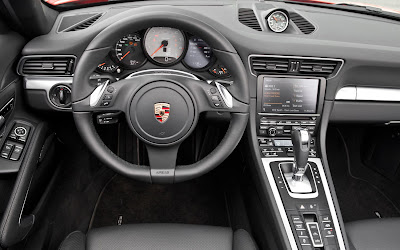With the Porsche 911 Carrera S Cabriolet, Dr. Ing. h.c. F. Porsche AG, Stuttgart, is doubling the driving fun to be had from the new 911 Carrera by putting a Cabriolet alongside the Coupé. The debut of the new generation of the sports car classic is being followed only a few months later by the open-top models of the 911 Carrera and 911 Carrera S in the new 911 design.
2013 Porsche 911 Carrera S Cabriolet
2013 Porsche 911 Carrera S Cabriolet
2013 Porsche 911 Carrera S Cabriolet
2013 Porsche 911 Carrera S Cabriolet
2013 Porsche 911 Carrera S Cabriolet
What the Coupé began with the new aluminium-steel body, the Cabriolet continues with the all-new, unique hood: As a result, the typical 911 roof line is initially retained in its entirety. Even when closed up, the Cabriolet cuts a fine figure. Intelligent lightweight design, even including the use of magnesium in the hood, ensures less weight and more sportiness, lower fuel consumption and greater comfort. With the open-top 911s as well, Porsche has managed to reverse the weight spiral and make the new Cabrio models significantly lighter than its predecessors.
Each of the two new Cabriolets has the same engine as its Carrera Coupé equivalent. The rear of the 911 Carrera Cabrio houses a 3.4-litre flat engine generating 350 hp (257 kW) of power driving the rear wheels through a seven-gear manual transmission. The open-top Porsche 911 Carrera S Cabriolet comes with a 3.8-litre six-cylinder engine developing 400 hp (294 kW) and also a seven-gear manual transmission featured as standard. That means that the open-top 911s as well are distancing themselves even further from the competition in terms of efficiency; both models consume less than ten litres of fuel per 100 kilometres (NEDC). The Cabriolets as well have the Porsche Doppelkupplungsgetriebe (PDK) available as an optional extra, delivering even lower fuel consumption and shorter acceleration times.
With the longer wheelbase compared with the predecessor model, the wider front track and the new electro-mechanical power steering, the new Cabriolets offer even sportier driving characteristics, greater precision and agility. Depending on model, there are other standard or optional active control systems available as well that further enhance the driving dynamics.
The 911 Carrera Cabriolet will be launched in Germany on March 3, 2012. The prices for the Porsche 911 Carrera Cabriolet start in Germany with 100,532 Euros, the Porsche 911 Carrera S Cabriolet starts with 114,931 Euros including value-added tax in both cases.
Top performance courtesy of Porsche Dynamic Chassis Control
A critical contribution to the impressive performance enhancement of the new 911 generation is made by Porsche Dynamic Chassis Control (PDCC), available as an option for the 911 Carrera S. Equipped with this system, the open-top model as well achieves a new level of lateral acceleration and handling. The vehicle's lateral inclination, for example when entering a bend, when cornering and changing lanes at speed is almost completely offset by the variable stabiliser system up to the maximum lateral acceleration.
Technical Specification
- Porsche 911 Carrera Cabriolet: 3.4-litre boxer engine with 350 hp (257 kW); rear-wheel drive, seven-speed manual transmission, optional seven-speed Porsche-Doppelkupplungsgetriebe (PDK); acceleration 0 - 100 km/h in 5.0 seconds, with PDK in 4.8 seconds (4.6 seconds with Sport Chrono Package); top speed 286 km/h, with PDK 284 km/h; fuel consumption (NEDC) 9.2 l/100 km, CO2 217 g/km; with PDK 8.4 l/100 km CO2 198 g/km.
- Porsche 911 Carrera S Cabriolet: 3.8-litre boxer engine with 400 hp (294 kW); rear-wheel drive, seven-speed manual transmission, optional seven-speed Porsche-Doppelkupplungsgetriebe (PDK); acceleration 0 - 100 km/h in 4.7 seconds, with PDK in 4.5 seconds (4.3 seconds with Sport Chrono Package); top speed 301 km/h, with PDK 299 km/h; fuel consumption (NEDC) 9.7 l/100 km, CO2 229 g/km; with PDK 8.9 l/100 km CO2 210 g/km.
Articles Source : NetcarShow





No comments:
Post a Comment